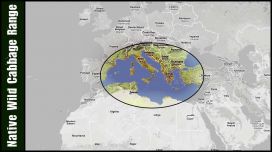Wild Cabbage
Brassica oleracea
A Domesticated Mustard
Brassica oleracea (otherwise known as wild cabbage or wild mustard) is an incredibly diverse assemblage of edible plants that, while they appear to be different species, are in fact cultivars of the same species.
Where is wild cabbage native?
Brassica oleracea is native to southern and western Europe. It grew primarily in coastal areas as it has high salt- and lime-tolerance. It was not a very good competitor in open prairies and thus was restricted naturally to limestone sea cliffs.
Characteristics of the native form
Wild Cabbage is a biennial plant which means that it takes two years to reach maturity, set seed, and die. It forms a rosette of large leaves in the first year; in the second year it produces a large flower spike up to seven feet tall. The wild form has yellow flowers.
How did wild cabbage become what we have today?
The cultivation of wild cabbage is not yet clear, although we know that both Greeks and Romans used this plant extensively as a garden vegetable. One of the main benefits of using this plant as a vegetable is its ability to store starch and essential nutrients (such as Vitamin C).
Today the cultivars of Brassica oleracea are divided into seven major groups. These groups are categorized by developmental form. These are as follows:
- Acephala Group: kale and collard greens
- Alboglabra Group: chinese broccoli
- Botrytis Group: cauliflower, Romanesco broccoli and broccoflower
- Capitata Group: cabbage
- Gemmifera Group: brussels sprouts
- Gongylodes Group: kohlrabi
- Italica Group: broccoli
Interesting facts
A few of the cultivars (especially brussels sprouts and broccoli) have high levels of sinigrin, a compound that may aid in the prevention of bowel cancer.
Good links to information about Brassica oleracea
Related Topics
A Domesticated Mustard
Brassica oleracea (otherwise known as wild cabbage or wild mustard) is an incredibly diverse assemblage of edible plants that, while they appear to be different species, are in fact cultivars of the same species.
Where is wild cabbage native?
Brassica oleracea is native to southern and western Europe. It grew primarily in coastal areas as it has high salt- and lime-tolerance. It was not a very good competitor in open prairies and thus was restricted naturally to limestone sea cliffs.
Characteristics of the native form
Wild Cabbage is a biennial plant which means that it takes two years to reach maturity, set seed, and die. It forms a rosette of large leaves in the first year; in the second year it produces a large flower spike up to seven feet tall. The wild form has yellow flowers.
How did wild cabbage become what we have today?
The cultivation of wild cabbage is not yet clear, although we know that both Greeks and Romans used this plant extensively as a garden vegetable. One of the main benefits of using this plant as a vegetable is its ability to store starch and essential nutrients (such as Vitamin C).
Today the cultivars of Brassica oleracea are divided into seven major groups. These groups are categorized by developmental form. These are as follows:
- Acephala Group: kale and collard greens
- Alboglabra Group: chinese broccoli
- Botrytis Group: cauliflower, Romanesco broccoli and broccoflower
- Capitata Group: cabbage
- Gemmifera Group: brussels sprouts
- Gongylodes Group: kohlrabi
- Italica Group: broccoli
Interesting facts
A few of the cultivars (especially brussels sprouts and broccoli) have high levels of sinigrin, a compound that may aid in the prevention of bowel cancer.

































































































